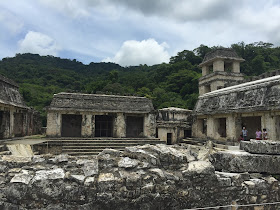Palenque is one of the most spectacular and easily accessible Classic Maya ruins. I first visited the site in 1991 and a lot has changed--many more visitors and vendors, and more of the ruins have been excavated. We got there during the heat of the day, so birds were quiet and few and far between, but we did see some
Keel-billed Tucans as well as a
Bat Falcon harassing a
Short-tailed Hawk. The museum was closed the first day we were there, due to a power outage, but when we returned a week later the museum was open and we enjoyed seeing more of the artifacts from this site. For more on the birds of Palenque,
check out this paper.
Here are a few shots of the ruins as well as some Classic Maya bird imagery from Palenque. Birds were an important part of Classic Maya communities and culture. They continue to be important in many Maya communities today, making our research into modern and ancient Maya bird connections a lot of fun.
 |
| White Palace at Palenque Ruins. Most Classic Maya architecture was probably plastered and painted red, but this palace was white and would have made an imposing sight. |
 |
| Birding above the White Palace |
 |
| Great tacos al pastor in the city of Palenque. Best tacos of the trip. |
 |
| Classic maya often pictured their gods and leaders as taking on the form of a bird. |
 |
| The mat bird glyph, part of the name of an important site or precinct at Palenque. We don't know for sure yet which bird this is, but we did recover a water bird name with mat in it among the Chontal Maya this trip, so maybe we're close? |
 |
| Presumed screech owl head in a belt decoration. |
 |
| An undeciphered Maya glyph, presumably a royal name or title. Because the bird is holding a fish, has a crest, and a black line through the eye, I think it is an Osprey, but so far we haven't found a Maya name for the Osprey that ends in N, which it would need to have in order to match the phonetic complement attached to it in another inscription. |
 |
| Birds often decorate headdresses and incense burners. Sometimes they are real birds, and other times they may be the bird form or representation of a divine being or ruler. |
 |
| Another bird presumably as part of a god's headdress on this incense burner. |
 |
| An explanation of the sarcophagus cover of Pakal, perhaps one of the most famous Classic Maya carvings. At the top is the major Maya god Itzamnaaj in the form of the bird. |
 |
| Classic Maya glyph with the phonetic reading of "I"--a bird perhaps a vulture eating the eye of a jaguar. Interestingly we got a cool story about this from a Chol Maya village in Tabasco. |
 |
| Another Classic maya "bird man" |


































